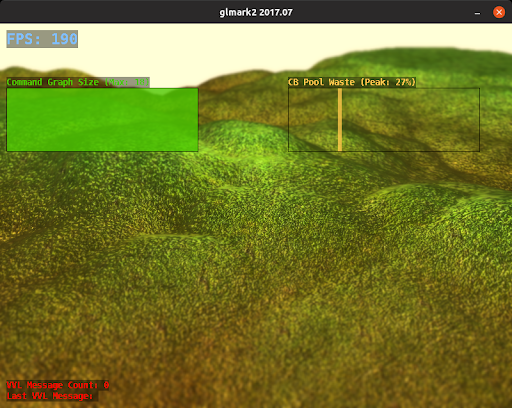# Debug Overlay in ANGLE's Vulkan Backend ## Motivation A complex application has frequently changing performance characteristics due to both a varying number of objects to draw and different effects that need to be applied to them. When characterizing the performance of an application, it can be easy to miss scenes which need optimization, especially if they are ephemeral. A debug overlay that shows on-the-fly statistics from the running application can greatly aid the developer in finding where the bottlenecks are and which scenes need further investigation and profiling. ANGLE's Vulkan debug overlay implements this. The initial implementation includes a few pieces of information for demonstration purposes. Here's the glmark2 *terrain* scene with these overlay items enabled:  This is a screenshot of a debug build, hence the low FPS. The command graph size widget no longer applies to current ANGLE code. ## Implementation Overlay items are of two fundamental types: * Text items: A single line of text with small or large font. * Graph items: A bar graph of data. These each have a Text item attached that is automatically rendered with the graph item. Built on these, various overlay item types are defined that gather statistics. Five such types are defined with one item per type as example: * **Count**: An item that counts something. **VulkanValidationMessageCount** is an overlay item of this type that shows the number of validation messages received from the validation layers. * **Text**: A generic text widget. **VulkanLastValidationMessage** is an overlay item of this type that shows the last validation message. * **PerSecond**: A value that gets reset every second automatically. **FPS** is an overlay item of this type that simply gets incremented on every `swap()`. * **RunningGraph**: A graph of the last N values. **VulkanRenderPassCount** is an overlay of this type. This counter reports the number of RenderPasses rendered in each vkQueueSubmit call. * **RunningHistogram**: A histogram of last N values. Input values are in the [0, 1] range and they are ranked to N buckets for histogram calculation. **VulkanSecondaryCommandBufferPoolWaste** is an overlay item of this type. On `vkQueueSubmit()`, the memory waste from command buffer pool allocations is recorded in the histogram. Overlay font is placed in [libANGLE/overlay/](../src/libANGLE/overlay/) which [gen_overlay_fonts.py](../src/libANGLE/gen_overlay_fonts.py) processes to create an array of rasterized font data, which is used at runtime to create the font image (an image with one layer per character, and one mip level per font size). The overlay widget layout is defined in [overlay_widgets.json](../src/libANGLE/overlay_widgets.json) which [gen_overlay_widgets.py](../src/libANGLE/gen_overlay_widgets.py) processes to generate an array of widgets, each of its respective type, and sets their properties, such as color and bounding box. The json file allows widgets to align against other widgets as well as against the framebuffer edges. The following is a part of this file: ```json { "name": "VulkanValidationMessageCount", "type": "Count", "color": [255, 0, 0, 255], "coords": [10, "VulkanLastValidationMessage.top.adjacent"], "font": "small", "length": 25 }, { "name": "VulkanSecondaryCommandBufferPoolWaste", "type": "RunningHistogram(50)", "color": [255, 200, 75, 200], "coords": [-50, 100], "bar_width": 6, "height": 100, "description": { "color": [255, 200, 75, 255], "coords": ["VulkanSecondaryCommandBufferPoolWaste.left.align", "VulkanSecondaryCommandBufferPoolWaste.top.adjacent"], "font": "small", "length": 40 } } ``` Negative coordinates in this file indicate alignment to the right/bottom of the framebuffer. `OtherItem.edge.mode` lets an item be aligned with another. If `mode` is `align`, the item has the same origin as `OtherItem` and expands in the same direction. If `adjacent`, the item expands in the opposite direction. The UI is rendered in two passes, one draw call for all graph widgets and another draw call for all text widgets. The vertex shader in these draw calls generates 4 vertices for each instance (one instance per widget) based on the widget bounding box. The fragment shader renders font or a graph based on widget data. This is done once per frame on `present()`, and the result is blended into the swapchain image. To build ANGLE with overlay capability, `angle_enable_overlay = true` must be placed in `args.gn`. Currently, to enable overlay items an environment variable is used. For example: On Desktop: ```commandline $ export ANGLE_OVERLAY=FPS:VulkanSecondaryCommandBufferPoolWaste $ ./hello_triangle --use-angle=vulkan ``` On Android: ``` $ adb shell setprop debug.angle.overlay FPS:VulkanSecondaryCommandBufferPoolWaste $ ./hello_triangle --use-angle=vulkan ``` ## Future Work Possible future work: * On Android, add settings in developer options and enable items based on those. * Spawn a small server in ANGLE and write an application that sends enable/disable commands remotely. * Move the Overlay rendering functionality to the front-end to benefit all backends. * Add more overlay widgets. * Implement automatic widget layout to remove the need to specify positions in the overlay widgets JSON.